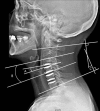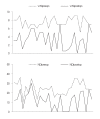Surgical outcome of cervical arthroplasty using bryan(r)
- PMID: 20062568
- PMCID: PMC2803268
- DOI: 10.3340/jkns.2009.46.6.532
Surgical outcome of cervical arthroplasty using bryan(r)
Abstract
Objective: Recently, motion preservation has come to the forefront of emerging technologies in spine surgery. This is the important background information of the emergence of cervical arthroplasty as an alternative to arthrodesis that offers the promise of restoring normal spinal movement and reduces a kinematic strain on adjacent segments. The study was designed to evaluate early surgical outcome and radiological effects of Bryan(R) cervical disc prosthesis.
Methods: The authors retrospectively reviewed radiographic and clinical outcomes in 52 patients who received the Bryan(R) Cervical Disc prosthesis, for whom follow-up data were available. Static and dynamic radiographs were measured by computer to determine the angles formed by the endplates of the natural disc preoperatively, those formed by the shells of the implanted prosthesis, the angle of functional spine unit (FSU), and the C2-7 Cobb angle. The range of motion (ROM) was also determined radiographically, whereas clinical outcomes were assessed using Odom's criteria, visual analogue pain scale (VAS) and neck disability index (NDI).
Results: A total of 71 Bryan(R) disc were placed in 52 patients. A single-level procedure was performed in 36 patients, a two-level procedure in 13 patients, and a three-level procedure in 3. Radiographic and clinical assessments were made preoperatively. Mean follow-up duration was 29.2 months, ranging from 6 to 36 months. All of the patients were satisfied with the surgical results by Odom's criteria, and showed significant improvement by VAS and NDI score (p < 0.05). The postoperative ROM of the implanted level was preserved without significant difference from preoperative ROM of the operated level (p < 0.05). 97% of patients with a preoperative lordotic sagittal orientation of the FSU were able to maintain lordosis. The overall sagittal alignment of the cervical spine was preserved in 88.5% of cases at the final follow up. Interestingly, preoperatively kyphotic FSU resulted in lordotic FSU in 70% of patients during the late follow up, and preoperatively kyphotic overall cervical alignment resulted in lordosis in 66.6% of the patients postoperatively.
Conclusion: Arthroplasty using the Bryan(R) disc seemed to be safe and provided encouraging clinical and radiologic outcome in our study. Although the early results are promising, this is a relatively new approach, therefore long-term follow up studies are required to prove its efficacy and its ability to prevent adjacent segment disease.
Keywords: Arthroplasty; Artificial disc; Bryan®; Cervical disc.
Figures


Similar articles
-
Effects of a cervical disc prosthesis on maintaining sagittal alignment of the functional spinal unit and overall sagittal balance of the cervical spine.Eur Spine J. 2008 Jan;17(1):20-9. doi: 10.1007/s00586-007-0459-y. Epub 2007 Aug 25. Eur Spine J. 2008. PMID: 17721713 Free PMC article. Clinical Trial.
-
Comparison of radiographic changes after ACDF versus Bryan disc arthroplasty in single and bi-level cases.Eur Spine J. 2009 Feb;18(2):218-31. doi: 10.1007/s00586-008-0854-z. Epub 2009 Jan 6. Eur Spine J. 2009. PMID: 19127374 Free PMC article. Clinical Trial.
-
Effects of a cervical disc prosthesis on segmental and cervical spine alignment.Neurosurg Focus. 2004 Sep 15;17(3):E5. doi: 10.3171/foc.2004.17.3.5. Neurosurg Focus. 2004. PMID: 15636561
-
Early clinical and biomechanical results following cervical arthroplasty.Neurosurg Focus. 2004 Sep 15;17(3):E9. doi: 10.3171/foc.2004.17.3.9. Neurosurg Focus. 2004. PMID: 15636565 Review.
-
Long-Term Clinical and Radiographic Outcomes After Bryan Cervical Disk Arthroplasty: A Systematic Literature Review.Acta Neurochir Suppl. 2023;135:321-329. doi: 10.1007/978-3-031-36084-8_49. Acta Neurochir Suppl. 2023. PMID: 38153488
Cited by
-
Multi-level cervical disc arthroplasty (CDA) versus single-level CDA for the treatment of cervical disc diseases: a meta-analysis.Eur Spine J. 2015 Jan;24(1):101-12. doi: 10.1007/s00586-014-3429-1. Epub 2014 Jun 25. Eur Spine J. 2015. PMID: 24961223 Review.
-
Cervical artificial disc replacement versus fusion in the cervical spine: a systematic review comparing multilevel versus single-level surgery.Evid Based Spine Care J. 2012 Feb;3(S1):19-30. doi: 10.1055/s-0031-1298605. Evid Based Spine Care J. 2012. PMID: 23236310 Free PMC article.
-
Cervical Radiculopathy due to Cervical Degenerative Diseases : Anatomy, Diagnosis and Treatment.J Korean Neurosurg Soc. 2010 Dec;48(6):473-9. doi: 10.3340/jkns.2010.48.6.473. Epub 2010 Dec 31. J Korean Neurosurg Soc. 2010. PMID: 21430971 Free PMC article.
-
One-Level Versus 2-Level Treatment With Cervical Disc Arthroplasty or Fusion: Outcomes Up to 7 Years.Int J Spine Surg. 2019 Dec 31;13(6):551-560. doi: 10.14444/6076. eCollection 2019 Dec. Int J Spine Surg. 2019. PMID: 31970051 Free PMC article.
-
Five-year results of cervical disc prostheses in the SWISSspine registry.Eur Spine J. 2013 Aug;22(8):1723-30. doi: 10.1007/s00586-013-2770-0. Epub 2013 Apr 13. Eur Spine J. 2013. PMID: 23584163 Free PMC article.
References
-
- Anderson PA, Sasso RC, Rouleau JP, Carlson CS, Goffin J. The Bryan Cervical Disc : wear properties and early clinical results. Spine J. 2004;4:303S–309S. - PubMed
-
- Bohlman HH, Emery SE, Goodfellow DB, Jones PK. Robinson anterior cervical discectomy and arthrodesis for cervical radiculopathy. Long-term follow-up of one hundred and twenty-two patients. J Bone Joint Surg Am. 1993;75:1298–1307. - PubMed
-
- Clements D, O'Leary PF. Anterior cervical discectomy and fusion. Spine. 1990;15:1023–1025. - PubMed
-
- Cloward RB. The anterior approach for removal of ruptured cervical disks. J Neurosurg. 1958;15:602–617. - PubMed
LinkOut - more resources
Full Text Sources
Miscellaneous

